On Thursday, the EUR/USD pair is testing the key resistance level of 1.1660, which corresponds to the middle line of the Bollinger Bands indicator on the weekly (W1) timeframe. The pair is climbing steadily, and not solely due to the broad weakness of the U.S. dollar. The euro is also playing its part, responding positively to recent political developments in France.

But first, let's address a key question—why is the dollar weakening? Not long ago, the U.S. dollar was in strong demand as a safe-haven asset, but over the last three days, the U.S. Dollar Index has been on a consistent decline. Major dollar pairs have shifted accordingly. In particular, EUR/USD sellers failed to break the 1.1550 support level, after which buyers took control of the pair. This shift occurred on October 14, right after Federal Reserve Chair Jerome Powell's speech. Dollar bulls reacted negatively to the Fed leader's tone, as he emphasized signs of a cooling U.S. labor market and essentially flagged a rate cut at the October meeting.
It's worth noting that even before Powell's remarks, the market already expected the Fed to deliver a 25-basis-point rate cut this month. Now, traders are convinced that another cut will follow in December, a scenario that only recently seemed uncertain. Currently, the probability of an October rate cut is priced at 97% (according to the CME FedWatch tool), while the likelihood of an additional December cut stands at 94%. Needless to say, that speaks volumes. Moreover, the market is now assigning a 50% chance of yet another cut in January—bringing the total expected reduction to 75 basis points.
Only the September Nonfarm Payrolls and inflation data could confirm or challenge these expectations, but due to the government shutdown, their release has been postponed indefinitely. The only exception is the Consumer Price Index (CPI), scheduled for October 24. Should it reflect stagnation or a slowdown in inflation, the dollar will come under additional pressure, reinforcing expectations for a 50-basis-point rate cut by year-end.
The ongoing U.S. government shutdown also plays a significant role in the dollar's weakness. Now into its 16th day, the standoff is costing the U.S. economy an estimated $15 billion per week in lost GDP, according to the White House. Each day of inactivity is an indirect blow to the dollar. And with both Democrats and Republicans refusing to compromise, this shutdown could become one of the longest on record.
Meanwhile, in France, the political crisis has finally reached a resolution: lawmakers rejected a no-confidence vote against Prime Minister Sebastien Lecornu's government. While this is only a temporary pause in political tensions, the euro responded positively to the news.
In short, Lecornu—a close ally of President Emmanuel Macron—initially resigned after just 27 days in office due to clashes with parliament. Macron reappointed him as prime minister, warning that a vote of no confidence would result in the dissolution of parliament and early elections. Ultimately, Lecornu avoided a second resignation, primarily by agreeing to postpone the unpopular pension reform.
On the one hand, this is not a happy ending, as the core problems of the political crisis remain unresolved. The parliament remains fragmented with no clear majority, and far-right and certain left-wing factions continue to call for a government reset. On the other hand, Macron avoided the most negative political outcome—including for the euro—by averting snap elections that could have strengthened right-wing forces with uncertain consequences.
Additional pressure on the dollar came from the release of the Philadelphia Fed Manufacturing Index, which unexpectedly fell to -12.8 points in October. Most analysts had forecast growth to 8.6. This sharp decline highlights a significant drop in industrial activity in Philadelphia and surrounding regions.
Taken together, this fundamental backdrop supports further growth in EUR/USD. However, it is advisable to consider long positions only after the pair firmly breaks above the 1.1660 resistance level, which aligns with the upper boundary of the Kumo cloud on the H4 chart and with the middle Bollinger Bands line on the W1 timeframe. The pair has attempted several times on Thursday to break and hold above this level, but so far, they have been unsuccessful. Therefore, long positions will become relevant only when the EUR/USD bulls finally overcome this level and consolidate above it. In that case, the next bullish targets will be 1.1690 (upper Bollinger Band on the H4 timeframe) and 1.1730 (Kijun-sen line on the D1 timeframe).





















